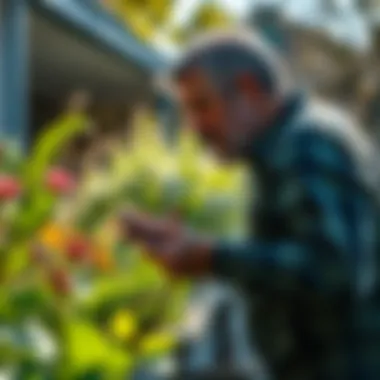Understanding Local Pest Control: Roles & Insights


Intro
Pest control isn't just about eliminating unwanted critters. It's a dance with nature that requires expertise, patience, and a keen understanding of how pests behave and interact with their surroundings. The local bug guy—or gal, as it were—stands at the forefront of this endeavor, armed not just with spray cans and traps, but also invaluable knowledge about pest identification, prevention methods, and tailored solutions for homeowners.
In our lively homes, various insects can become unwelcome residents, disrupting our daily lives and even causing potential health risks. That's where the local bug professional steps in, wearing many hats to ensure our living spaces remain cozy and pest-free. From identifying common household pests to crafting eco-friendly strategies, these experts play a crucial role in protecting our environments.
As we delve deeper into this multifaceted role, we will explore key dimensions of pest management. It's essential for homeowners, especially those who take pride in maintaining a clean and safe home, to grasp the full picture. Not merely through conventional methods but also via understanding the ecosystems around us. Let’s get started!
Pest Identification
Common Household Pests
When we think about pests, what typically comes to mind? Roaches, ants, termites, and, let’s not forget, the tenacious bedbugs. These are just a slice of the pest pie that can invade our sanctuaries. Each pest has its own peculiarities and life cycles. For instance, a cockroach might be more than just a nuisance; they can trigger allergies and spread diseases.
- Ants: Often seen marching in a line, they invade kitchens and pantries. Some species, like the carpenter ant, can even damage wood structures.
- Termites: Silent destroyers, these wood-loving insects can cause serious structural issues, costing homeowners thousands if left unchecked.
- Bedbugs: Tiny invasive pests that thrive on blood, they have become a modern-day headache for many, leading to restless nights.
The list goes on, pinching and gnawing away at the comforts of home.
Signs of Infestation


Identifying pests before they multiply can be tricky, but several telltale signs can help. Spotting a single bug might not raise alarm bells, but when you see certain indicators, you should start taking action:
- Droppings: Small, dark specks often hint at rodent activity. For roaches, you might notice grease marks or tiny casings.
- Nests or Burrows: Ants and rodents make nests that can sometimes be seen in hidden areas, like behind cabinets or inside walls.
- Unexplained Bites: If you wake up with itchy welts, it could indicate bedbug presence.
- Damage: Sawdust-like debris around wooden fixtures often points to termites at work.
“Early detection is key! The sooner you identify an infestation, the easier—and cheaper—it is to manage.”
Prevention Methods
Environmental Modifications
Pest prevention is often more effective than remediation. Adjusting your home environment can significantly minimize the risk of pest invasions. Small changes can make a big difference, such as:
- Seal Entry Points: Pests are crafty. Inspect your home for cracks in windows and doors, and seal them to keep unwelcome visitors out.
- Eliminate Standing Water: Pests like mosquitoes are drawn to stagnant water. Regularly check for puddles, clogged gutters, or even bird baths that aren't maintained.
Home Maintenance Tips
Regular upkeep goes a long way in safeguarding against pests. Consider these tips:
- Declutter: Piled-up papers and old boxes create cozy hiding spots for pests.
- Food Storage: Make sure you’re storing food in airtight containers. Pests have a knack for finding weak spots in even the best-organized kitchen.
Staying one step ahead of pesky intruders requires vigilance and a proactive mindset.


DIY Pest Control Solutions
Natural Remedies
For those who prefer a more green approach, nature is often the best friend in pest control. There are various DIY methods that are both effective and eco-friendly:
- Vinegar Spray: A solution of equal parts water and vinegar can deter ants and other small pests. Spray it around entry points to discourage their presence.
- Diatomaceous Earth: This natural powder can be sprinkled around the home. It's lethal to insects but safe for pets and humans.
DIY Traps and Barriers
You can even create your own pest traps. Here are some simple solutions:
- Homemade Ant Traps: Mix sugar with borax. This concoction lures ants, which then carry it back to their colony.
- Soap and Water Spray: A simple mixture can effectively immobilize pests such as aphids on plants.
Utilizing these methods not only helps manage pests but also reduces reliance on harmful chemicals.
Arming yourself with knowledge and proactive strategies can transform the way you manage pests in your home. Whether you decide to consult the local bug guy or tackle the issue yourself, understanding these fundamentals is pivotal. Embrace the journey of pest management and create a harmonious living space.
Prelude to Local Pest Control


Managing pests is more than just a nuisance; it can affect the health and comfort of your home. The role of local pest control experts—often referred to as the "local bug guy"—is crucial in helping homeowners navigate these issues effectively. This introduction sets the stage for understanding this vital profession, showcasing how these experts deploy their knowledge and skills to protect residential spaces.
Pest control is not merely about exterminating insects; it's about developing a comprehensive approach to managing these unwelcome visitors while ensuring the safety of people and pets in the home. One key element is the identification of pests. Knowing what you’re dealing with can make a world of difference. Certain pests may be mere annoyances, while others pose serious health risks. For instance, termites aren’t just a bother; they can decimate the structural integrity of a home.
Another important consideration is the prevention of infestations before they occur. Local bug guys equip homeowners with strategies that can significantly reduce the likelihood of an infestation. Simple steps like sealing entry points and maintaining cleanliness can go a long way. Plus, these experts often provide tailored solutions that reflect the specific needs of the local environment. The learning curve for homeowners can be steep, and having an experienced professional to guide them is invaluable.
Furthermore, as environmental considerations come to the forefront, the approach of pest control professionals evolves. More and more local bug guys are turning towards sustainable techniques that don't compromise the welfare of ecosystems.
"Local pest control is as much about caring for the environment as it is about managing pests. It's a balance between comfort in our homes and health for our planet."
In summary, understanding the role of local pest control services is pivotal not just for effective pest management but also for the holistic approach it offers toward maintaining a safe living space. We'll delve further into the specifics of what these professionals do and how they adapt their methods over time.
Common Pests Covered by Local Bug Experts
The importance of discussing common pests cannot be overstated. These uninvited guests can wreak havoc in a household, turning a cozy home into a battleground. Having a clear understanding of the insects, rodents, and wildlife that the local bug guy typically deals with provides homeowners with a strong foundation in pest management. Knowing about the enemy helps in formulating effective strategies to keep them at bay.
Insect Infestations
Insects are among the most frequent nuisances found in homes. Ants marching in lines, cockroaches scuttling under the sink, or wasps buzzing around outside can be just the tip of the iceberg. Each insect has its own behaviors and life cycles, making it critical to identify them correctly. The local bug guy relies heavily on knowledge regarding these critters to implement suitable treatments.
For example, a common house pest like the Asian cockroach is often confused with the German cockroach. However, understanding their differences is essential. The Asian variety is attracted to light, usually found outdoors, whereas German cockroaches are notorious for indoor infestations and breed rapidly. Effective pest control hinges on such nuanced differences, emphasizing why consulting an expert is beneficial.
plaintext Key indicators of insect infestations:
- Frequent sightings of insects
- Droppings or shed skins
- Damaged materials, including fabrics and food















